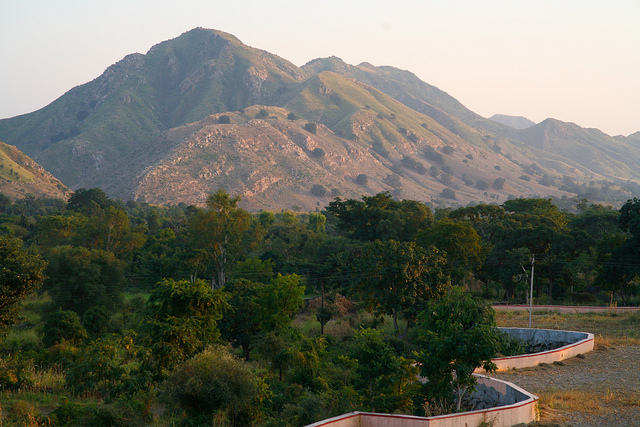It’s six in the morning. The moon is still out and the road is a silvery ribbon. In fact, ribbon is an apt description, for the road in front of us is just a narrow strip. Our driver Muhammad Hussain, however, negotiates it with remarkable ease. Possibly, his experience of driving around the Kumbhalgarh Wildlife Sanctuary for four years has made him an expert.
As the sun begins its slow climb up the sky, the tall grass on the sides of the road glimmers in the first light of the day. The Kumbhalgarh Wildlife Sanctuary is a field of gold but none of its residents are out basking in the sun. Then a crested hawk eagle swoops down on one of the branches, its prominent crest bobbing up and down. The view is spectacular from the point where we are at Mahuti Khet, a dense cluster of mahua trees, also a favourite haunt of langurs. We can see the Kumbhalgarh Fort, which has given the sanctuary its name. The fort rises above the forest, a picture of formidable isolation. We get off the jeep, lingering in this patch of rustling trees, till the driver, eager to get on, woos us away with promises of bigger and better sights.
We reach Choti Aodhi, once a hunting ground for the then rulers of Ghanerao, now a waterhole where animals and wildlife enthusiasts alike break journey. Along the way, a young sambar looks out anxiously, hidden partially by a rock. At Thandi Beri, we meet a French couple who have spotted only sambar, and our travel agent pitches in with an explanation: “This year, we have had good rain, and there’s water all over the sanctuary, so animals don’t necessarily come to these waterholes.” He adds, “Evening is a better time to spot animals.” We make our way back from Thandi Beri, taking in the wild purple flowers brightening the forest. Grey jungle fowl run zigzag on the path for a while, and for no apparent reason dart off into the bushes. They add to the forest atmosphere with some spirited screeching. We return to the hotel, with the sounds and smells of the forest with us.
The following day, we visit the famous 15th century Jain temples at Ranakpur, located at one end of the sanctuary. We make our way back to Kumbhalgarh via Ghanerao and the Muchala Mahaveer Temple. In the twilight hour, as the candles inside the old Jain temple flicker hauntingly, darkness takes on another meaning. Heading back to Kumbhalgarh, we sit shivering slightly in the open jeep, the road once again a ribbon of moonlight.
From somewhere in the darkness materialises the spotted-inky coat of a panther. It crosses the road in a lightening flash, disappearing from one dark patch of forest to another. “See,’’ says our all-knowing travel agent, “I told you evening is a better time to come to the forest.’’ For once, we can’t help but agree.
Quick Facts
State: Rajasthan
Location: Near the formidable Kumbhalgarh Fort, the sanctuary is spread across
Rajsamand, Udaipur and Pali districts. The famous 15th century Jain temples at Ranakpur
lie to the west of the sanctuary
Distances: 84 km N of Udaipur, 372 km SW of Jaipur
Route from Udaipur: NH76 to Isphal; district roads to Kumbhalgarh WLS via Losingh
crossing, Barwarha, Auda and Kelwara Route from Jaipur NH8 to Rajnagar via Ajmer,
Beawar and Kelwa; state road to Kumbhalgarh
When to go: Open through the year Best sightings Dec to Mar
Go there for; Leopards, wolves, sloth bears, panthers
About the Author
Devyani Onial is an Inlaks scholar and completed her education at Columbia University, New York. A journalist with Indian Express in New Delhi, she enjoys writing on travel and wildlife.






